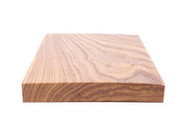Why Acacia is Becoming a Popular Wood for Cutting Boards
Posted by Grant Chen on 17th Oct 2024

What is Acacia Wood?
Acacia (also known as thorntree), is a natural wood that is becoming trendy and popular for use in cutting boards. Historically, acacia has been a prized wood because of its beauty and strength. The Bible references a special genus of red acacia that grows in East Africa as the wood that was used to build The Ark of the Covenant and Noah’s Ark. Acacia seeds and leaves have been used for medicinal purposes while acacia essence has been used as a perfume for centuries. In modern times, it's common to find acacia used in fine furnishings, flooring, decorative art and in the kitchen. See our collection of acacia cutting boards here.
How does Acacia Wood rank amongst the traditional cutting board materials?
While traditional hard woods such as maple, oak, cherry and walnut have all remained desirable for their appearance and functionality, these woods can still run upwards of $100 for a quality edge grain board, while an end grain butcher block can sell for upwards of $300. These high price points have opened up the door for materials such as bamboo, which are relatively cheap in comparison while holding up just as well (if not better) than the classic hard woods. Acacia wood cutting boards have proved time and time again that they can last in the kitchen just as much as a traditional wood cutting board can.
Countries with plentiful access to acacia such as Thailand, Vietnam, Indonesia and India have taken a cue from the popularity of bamboo and have begun exporting acacia as a substitute for the higher priced hard woods as well. Unlike bamboo however (which is technically a “grass”), acacia is a genuine hard wood rich with natural oils that gives it a natural water resistance. Bamboo on the other hand resists water due to the density of the wood instead of oils, which means knives will dull faster on bamboo vs acacia or other hard woods.
With over 1,300 species of acacia world-wide, including Australia, Africa, North and South America, Europe and Asia, acacia is an abundant and fast growing species that is not on any endangered list (such as certain species of teak). Acacia is fairly cheap per lineal foot due to the greater availability of sourcing. While woods such as maple, cherry and walnut have traditionally been used for cutting boards, these species are predominantly grown in the United States and are difficult to acquire for woodworkers overseas. As such, with an abundant supply of Acacia elsewhere, we are seeing a lot more enter the US market.
How are Acacia Wood Cutting Boards made?

Unlike domestic woods, Acacia is often harvested at a young age, which makes for smaller planks and wood strips. This in turns leads to many Acacia cutting boards being made using end grain or joined edge construction, which provides a checkered or styled look to the board. This has the effect of looking very similar to walnut wood, though true Acacia is a blond color and most of the Acacia seen in use is colored with a finish or food safe dye.
Highly plentiful, good looking and with fair performance in the kitchen, it's no wonder why Acacia is quickly becoming a popular choice for cutting boards. Most importantly, Acacia is affordable. In short, there’s nothing not to like, which is why this wood is going to continue gaining in popularity for use in cutting boards.

